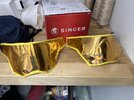- Member DIN
- S410
I’m not sure what kind of plastic the face shields are made from. I have used the tinted face shields for flat visors before. They work best for flat visors like the ones for mandalorian helmets. I haven’t vacuum formed one of those shieldsI'll try this for my CQC build! Has anyone ever used face shields from the COVID era as visors? I feel like they'd work pretty well, since they're flexible enough.


